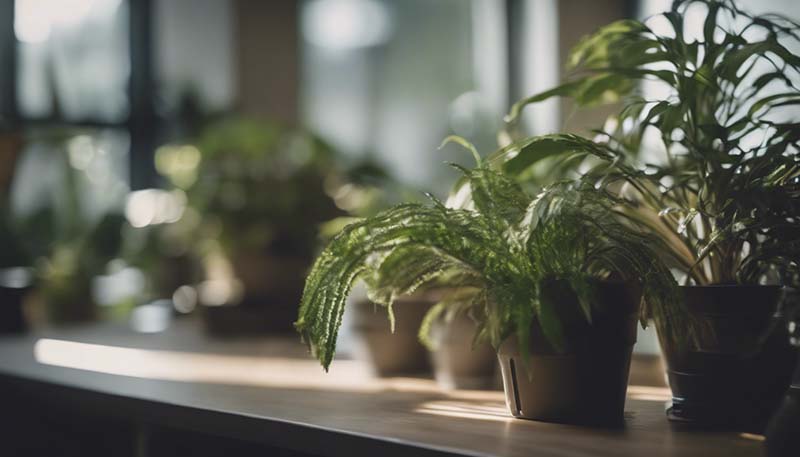The Best Indoor Plants for Low Light Conditions
=============================================
Introduction
------------
Indoor plants are a great way to add life and color to your home. They can also improve air quality and create a calming environment. However, not all plants thrive in the same conditions. Some plants require a lot of sunlight, while others can tolerate low light conditions. In this article, we will discuss the best indoor plants for low light conditions.
Benefits of Indoor Plants for Low Light Conditions
--------------------------------------------------
There are several benefits to having indoor plants in low light conditions. Here are some of the advantages:
1. **Air Purification**: Indoor plants can help purify the air by absorbing toxins and pollutants. This is especially important for people who suffer from allergies or asthma.
Advertisement
2. **Stress Reduction**: Studies have shown that having plants in your home can help reduce stress and anxiety. They can also improve your mood and overall well-being.
3. **Aesthetic Appeal**: Indoor plants can add a touch of beauty and elegance to your home. They can also help create a cozy and inviting atmosphere.
4. **Low Maintenance**: Some indoor plants require very little maintenance and can thrive in low light conditions. This makes them perfect for people who don't have a lot of time to take care of their plants.
Types of Indoor Plants for Low Light Conditions
-----------------------------------------------
Now that we know the benefits of having indoor plants in low light conditions, let's discuss some of the best plants to consider:
1. **Snake Plant (Sansevieria)**: Snake plants are one of the most popular indoor plants for low light conditions. They have long, slender leaves with a unique pattern and can tolerate low light levels.
2. **ZZ Plant (Zamioculcas zamiifolia)**: The ZZ plant is another great option for low light conditions. It has thick, glossy leaves and can survive in a variety of light conditions.
3. **Spider Plant (Chlorophytum comosum)**: Spider plants are easy to care for and can thrive in low light conditions. They have long, arching leaves and produce small plantlets that can be easily propagated.

4. **Peace Lily (Spathiphyllum)**: Peace lilies are a beautiful addition to any home. They have dark green leaves and produce white flowers that resemble calla lilies.
5. **Philodendron**: Philodendrons are a popular choice for indoor plants because they are easy to care for and can tolerate low light conditions. They come in various varieties, including heartleaf philodendron and split-leaf philodendron.
6. **Dracaena**: Dracaena is a group of plants that includes the corn plant and the dragon tree. They have long, slender leaves and can tolerate low light conditions.
7. **Pothos (Epipremnum aureum)**: Pothos is a popular trailing plant that can thrive in low light conditions. It has heart-shaped leaves that are green with yellow or white variegation.
8. **Cacti and Succulents**: While many cacti and succulents require bright light, there are some varieties that can tolerate low light conditions. Some options include the Christmas cactus, the zebra plant, and the echeveria.
9. **English Ivy (Hedera helix)**: English ivy is a popular trailing plant that can thrive in low light conditions. It has dark green leaves and can be easily propagated.
10. **Aloe Vera**: Aloe vera is not only a beautiful plant but also has many health benefits. It can tolerate low light conditions and requires very little maintenance.
How to Care for Indoor Plants in Low Light Conditions
-----------------------------------------------------
Now that we know some of the best indoor plants for low light conditions, let's discuss how to care for them:
1. **Watering**: Overwatering is a common mistake when caring for indoor plants. Make sure to water your plants only when the top inch of soil is dry. Be sure to use a well-draining potting mix to prevent root rot.
2. **Light**: While these plants can tolerate low light conditions, they still need some light to survive. Place them near a window that receives indirect sunlight or use a grow light to supplement natural light.
3. **Temperature**: Most indoor plants prefer temperatures between 65 and 75 degrees Fahrenheit. Avoid placing your plants near heating or cooling vents, as this can cause them to dry out.
4. **Humidity**: Many indoor plants prefer a humid environment. You can increase humidity by placing a tray of water near your plants or using a humidifier.
5. **Fertilizer**: Indoor plants generally require less fertilizer than outdoor plants. Fertilize your plants once a month during the growing season with a balanced, water-soluble fertilizer.
6. **Pruning**: Pruning is an important part of plant care. Remove any dead or yellowing leaves to promote new growth.
Conclusion
----------
Indoor plants can add beauty and life to your home while also improving air quality. If you have limited light in your home, consider choosing plants that can tolerate low light conditions. With proper care, these plants can thrive and bring joy to your home for years to come.
Comment